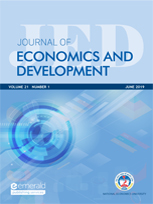Productivity growth and job reallocation in the Vietnamese manufacturing sector
Abstract
PurposeThe purpose of this paper is to measure TFP growth and job reallocation in the Vietnamese manufacturing industry after the Doimoi period.
Design/methodology/approach
The study uses firm-level panel data from Vietnam's annual enterprise survey data for 2000-2016 period in the Vietnamese manufacturing industry using Olley-Pakes static and dynamic productivity decomposition methods.
Findings
The aggregate productivity estimated from the WRDG method increased 2.323 percent, of which over 40 percent is due to the reallocation toward more productive firms. Olley-Pakes dynamic decomposition according to ownership, scale and industry shows that the contribution of private and state-owned firms and the contribution of small and medium firms and large firms to the TFP growth are 133, -33 percent, 58.56 and 41.44 percent, respectively. The within-firm productivity and net entry components are the main reasons for TFP growth rather than reallocation. The results show that the composition of the aggregate TFPs, estimated from WRDG, OP, LP and ACF, is correlated very high (over 80 percent) except for net entry components.
Research limitations/implications
The major limitation of this study is that the authors compute an aggregate productivity index using actual employment-based shares (still misallocation in labor), rather than optimal employment-based shares (no misallocation in labor).
Originality/value
Job reallocation between industries is attracting attention in developing countries, especially transition economies. However, knowledge about job reallocation among industries is limited. This paper assesses the level of job reallocation among private and state-owned firms, small and medium firms and large firms in Vietnam.

